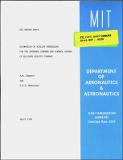| dc.description.abstract | This report describes a conceptual design for automation of the scheduling of airlift activities as part of the current upgrade of the MAC C2 System. It defines the airlift scheduling problem in generic terms before reviewing the current procedures used by MAC; and then a new scheduling system aimed at handling a very busy and dynamic wartime scenario, is introduced. The new system proposes "Airlift Scheduling Workstations" where MAC Airlift Schedulers would be able to manipulate symbolic information on a computer display to create and quickly modify schedules for aircraft, crews, and stations. For certain sub-problems in generating schedules, automated decision support algorithms would be used interactively to speed the search for feasible and efficient solutions. Airlift Scheduling Workstations are proposed to exist at each "Scheduling Cell", a conceptual organizational unit which has been given sole and complete responsibility for developing the schedule of activities for a specific set of airlift resources-aircraft by tail number, aircrew by name, and stations by location. A Mission Scheduling Database is located at each cell to support the Airlift Scheduling Workstation, and requires information communicated by Airlift Task Planners, and, Airlift Operators at many other locations. These locations would have smaller workstations with local databases, and database management software to assist Task Planners and Operators in viewing current committed and planned schedule information of particular interest to them, and to allow them to send information to the Mission Scheduling Database. The Command and Control processes for Airlift have been structured into a three level hierarchy in this report: Task Planning, Mission Scheduling, and Schedule Execution. Task Planners deal with Airlift Users and Mission Schedulers, but not Airlift Operators. Task Planning has three sub-processes: Processing User Requests; Assigning Requirements and Resources; and Monitoring Task Status. Task planning does not create missions, schedule the missions, or route aircraft. Mission Schedulers deal with Task Planners and Airlift Operators, but not Airlift Users. Mission Scheduling combines several sub-processes to allow efficient schedules to be quickly generated at the ASW (Airlift Scheduling Workstation). These sub-processes are: Mission Generation, Schedule Map Generation (for each type of aircraft), Crew Mission Sequence Generation, Station Schedule Generation, Management of Schedule Status, and Monitoring Schedule Execution and Resource Status. It is important that all these processes be co-located and processed by the Airlift Scheduling Cell. Schedule Execution is performed by Airlift Operators assigned by the scheduling process. It has three sub-processes: Monitor Assigned Schedules, Report Resources Assigned to Schedule, Report Local Capability Status. The assignment of local resources such as aircraft by tail, and crew by name is actually another scheduling process, but has not been studied in this report. Airlift Operators do not deal with Task Planners, but may deal with Airlift Users to finalize details of the scheduled operations. This three level hierarchy is compatible with the current organizational structures of MAC Command and Control. However, it is clear that both the current organizational structures and procedures of MAC Command and Control for both tactical and strategic airlift will be significantly affected by the introduction of the automated scheduling systems envisioned here. These changes will occur in an evolutionary manner after the upgraded MAC C2 system is introduced. | en_US |
| dc.description.sponsorship | Prepared for the Electronic Systems Division, Air Force Systems Command, USAF, Hanscom Air Force Base, Bedford, MA | en_US |
